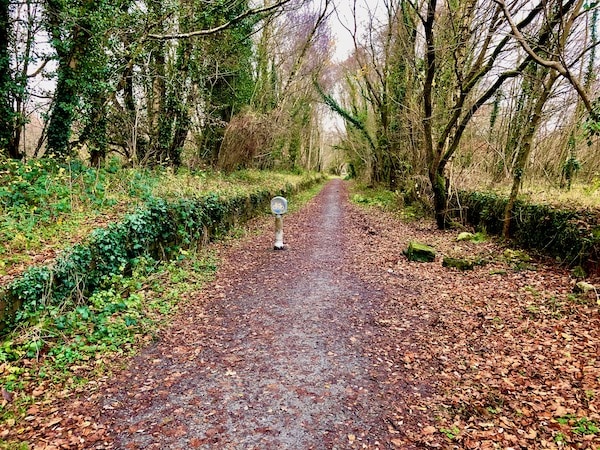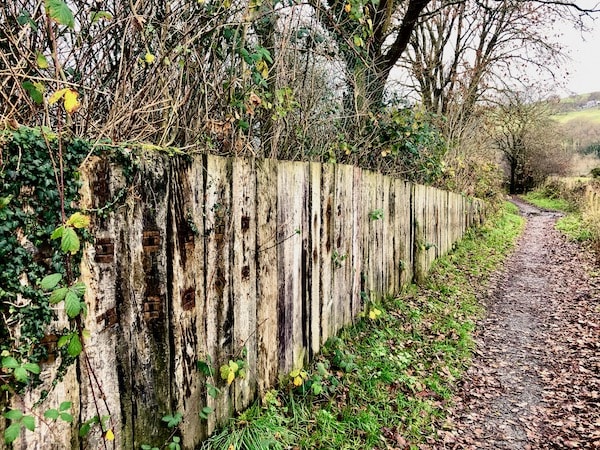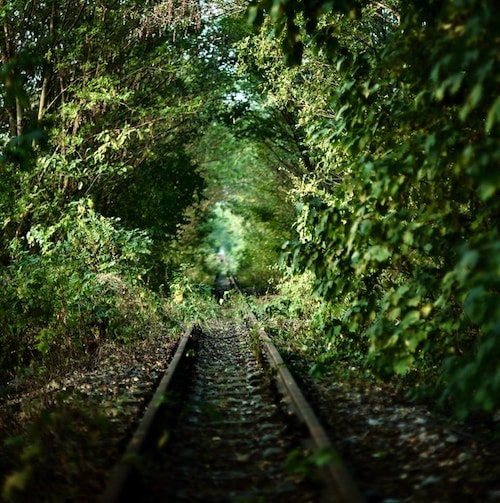Some miles outside a small Welsh town, off the main road, a long, flat structure rises from the undergrowth. Ivy and weed smother brick. The shape is familiar, but I have walked the whole length before I realise what it is – or was. Out in rural isolation, an abandoned railway platform is unexpected. The rails, sleepers and stone ballast are long since lifted. Signs and station buildings have gone, too. I pull out my phone and tap up the map to guess at what the stop might have been called. The mobile signal is too faint. The screen blanks: “Unable to connect”.
“Castles, forts, ruins, abandoned mines, empty buildings, depleted fisheries,” the cultural theorist Barbara Kirchenblatt-Gimblett (1997:5) tallies the body count on a visit to Wales, where “waning economies litter the landscape”. Death – of economies, and pasts, and with them futures – she concludes, “leaves a mess”.
Yet, among littered landscapes, ghosts lurk; afterlives – like a railway to nowhere, the spectral traces of a past that has left, and is left unresolved.
Death and disconnection
In the 1960s, the Beeching Report declared as uneconomic some 6,000km of UK rail track. At the time, the nationalised railways were haemorrhaging cash, and car ownership seemed the affluently oil-fuelled future. Scrapping lines and mothballing stations was as logical as it proved short-sighted. And, as the promise of infrastructure – connections mapped onto timetables; goings-from and gettings-to – gave way to ivy and isolation, a platform at a place once worth stopping for became a mortuary in the middle of nowhere. Shapely, forlorn.

From much of Wales, travelling by train to the capital, Cardiff, means a dog-leg route to England and back. Rather than North-South internal connections, pruned of branch lines, Welsh rail routes head West-East: afterlives of an extractive economy that carried Welsh resources to English industry. The mines now lie closed; the last steelworks totters; agriculture depends on soon-to-be-withdrawn CAP subsidies. David Harvey (2010) likens capital to clouds on a weather map, shifting place and pattern like a centuries-spanning rain radar.
Clouds of capital, moving on, leave the litter of past purpose to haunt present disconnection.
Into the ruins come post-industrial ‘spelunkers’ (Clemens 2011), cameras at the ready to capture economic departure as aesthetic melancholy. (The frisson might be less generously described as “‘dark tourism’ for the middle classes” [Strangleman 2013: 24].) Lurking ghosts duly await the intrepid; in empty factories, “cloakrooms contain the pegs and hangers which accommodated clothes; buttock-shapes remain embedded in more comfortable chairs” (Edensor 2005a: 841). Yet these are ghosts of the spatial kind, fixed and physical. In an essay theorising dead human bodies, Olga Cielemęcka (2015: 235) reflects that, “Remains … accompany us, the living, but at the same time we wish to delegate them to enclosed, ordered spaces, where they, as we believe, should belong.” The trouble with industry and infrastructure’s afterlives is that their hauntings do not hold neatly to their ruins. Spectres stray; the mess of economic death slips its bricks.
Welsh problems
Wales is often made legible to policy’s interventionary lens (Lea 2008) through a narrative of ‘Welsh problems’. On economic indicator maps and indices of multiple deprivation, Wales flares like a body bruised. In quite another context, Tess Lea (2014) writes of dwelling in spaces and places thick with policy – as saturated with the sense that something must be done, as steeped in the past failings of what was done.
In 2000, Wales first qualified for the highest band of EU regional development funding. The country’s devolved government had just been inaugurated amidst promises of a Welsh parliament for Welsh problems. Visions for a new future mingled with relief that Wales had been offered financial help to get there. There was, a now senior civil servant told me, remembering back, “Great fanfare that this … was going to open up our communities … would get them out of poverty.”
I did not reach the abandoned platform as an off-road explorer. I walked the railway to nowhere. The old track’s memory line has been smoothed into a cycling trail. A mile out of town, I saw a laminated sign tacked to a gate; the type small, the colour faded; mould beginning to fur at the edges. “Project part-financed by the European Union. Amcan 1 yn gweithio yng Ngheridigion. Objective 1 working in Ceredigion.” Underneath, a cartoon sticker struck a forbidding red line against dog shit. The words ‘Objective 1’ date the cycling trail project to the first tranche of EU funds into devolved Wales: the money that was going to open up our communities, and get them out of poverty.
Tourism is often reached for as an economic suture in rural Wales. In the sort of workshop sessions that arm stakeholders with coloured pens and post-it notes and ask them what to do about development in places where deprivation drifts behind mildewed windows and shuttered shops, again and again rolling green landscapes are jotted into fluorescent dreams. Build a leisure amenity and the tourists will come.
The Objective 1 fanfare is now as forgotten as the rail-to-trail’s unemptied dog waste bins. The civil servant I spoke with later recalled the end of that first seven-year EU funding period: “Our GDP per capital … hadn’t really changed … On the one hand, this was a bit of an indictment of all the money … on the other … we still actually want to stay under the threshold, because then we’ll qualify for another round of funding.” Failure, Lea (2008) observes, is but grist for policy’s ever grinding mill.
Resurrecting futures perfect
I have written elsewhere (Goodwin-Hawkins 2019) of how oddly easy it is to landscape defunct infrastructure into rurality – spaces made to freight commodities and facilitate connection yield to slower, simpler ways of life, so uncritically imagined. Abandoned railways bend obligingly to conversion because outdated transport technologies look and feel as quaint as a bright-painted steam engine. Old tracks traverse the countryside, turning to conveniently plotted rural trails. If rail is an archetype of industrial modernity, even smoke and piston -signalled progress can be decoupled, disconnected.
Yet, rail routes are difficult to spatially forget. They are deep-etched lines that decades of planning, mapping and land tenure order space round; plus, rural lines are rarely built over.
Without trains, without rails, lines remain durably present absences, holding stubbornly to past connection and hosting flickers of future promise.
Even cycleways serve to keep defunct infrastructure indelibly intact. Hopes of reconnection will whisper.

Afterlives are a “haunted present” (Muehlebach & Shoshan 2012:339), evoking loss, longing, and the hope of return. Writing on a closed tramline’s promised reinstatement, Laura Kemmer (2019: 61) reflects that infrastructural afterlives “come to make their own promises; they have promissory properties; they convey an indication of future events; they are full of potential.” Likewise, the railway to nowhere lingers in trace and talk, as “the infinite potential of a past … that might one day become a better future” (Kemmer 2019: 71).
The Welsh Government’s latest commissioned report on railway reinstatement turns promise into the dull thud of technical specification: “A fully workable end to end railway alignment has been defined, such that line speeds and journey times can be reliably assessed, whilst also enabling the identification of the full range of technical and implementation challenges to be resolved” (Mott MacDonald 2018:29). While construction costs and passenger projections are crunched, the railway to nowhere hovers between past conditional and future perfect (Shoshan 2012).
Budgets baulk at Welsh problems. Screens blank.
Across the border in England, the UK government sinks billions into cutting London-Birmingham rail journeys by an estimated ten minutes . Defunct infrastructure cannot but haunt disconnected space.
Nowhere, kept there
Recent election results and other statistical surprises have led to the rediscovery of so-called ‘left behind’ places. The narrative – academic and journalistic – frames discontent through developmental stasis, pairing luridly shaded maps with quasi-ethnographic quelle horreur. And, while the economic language of ‘lagging’ regions morphs into political promises to ‘level up’, these are all words without the weight of causality. To be left, to lag, to level under, is to be passively placed – activity, movement exists elsewhere. But … movement produces stasis. Success engenders failure. We are, Simin Davoudi insists, using the wrong language: places are not ‘left behind’, they are ‘kept behind’. Disconnected.
Departed economies. Development projects and funding regimes and feasibility studies.
Afterlives are flickering forms in the mess economic death has left.
Afterlives are more than forms. The spectral side of policy’s confident genre of fixes and futures, afterlives are the ghosts of pasts that were futures, kept back, never buried, haunting still the lines of dislocation in places once somewhere.
References
Cielemęcka, O. (2015). All things spectral. Somatechnics, 5(2): 234-254.
Clemens, P. (2011). Punching Out: One Year in a Closing Detroit Auto Plant. Doubleday: New York.
Edensor, T. (2005). The ghosts of industrial ruins: Ordering and disordering memory in excessive space. Environment and Planning D: Society and Space, 23(6): 829-849.
Goodwin-Hawkins, B. (2019). ‘Wild, Bleak Moors: Literary landscaping and the re-ruralisation of ‘Brontë Country’’. In L. McCracken Fletcher (Ed.) Literary Tourism and the British Isles: History, Imagination, and the Politics of Place. Lanham, Maryland: Lexington Books. Pp. 119-134.
Harvey, D. (2010). The Enigma of Capital and the Crises of Capitalism. Oxford: Oxford University Press.
Kemmer, L. (2019). Promissory things: how affective bonds stretch along a tramline. Distinktion: Journal of Social Theory, 20(1): 58-76.
Kirschenblatt-Gimblett, B. (1997). Afterlives. Performance Research, 2(2):1-9.
Lea, T. (2008). Bureaucrats and bleeding hearts: Indigenous health in northern Australia. UNSW Press, Sydney.
Lea, T. (2014). “From Little Things, Big Things Grow”: The Unfurling of Wild Policy. e-flux, 58. Available at: https://www.e-flux.com/journal/58/61174/from-little-things-big-things-grow-the-unfurling-of-wild-policy/
Mott MacDonald (2018). Aberystwyth to Carmarthen Line Rail Reinstatement: Feasibility Study. Transport for Wales. Available at: https://gov.wales/sites/default/files/publications/2018-10/aberystwyth-to-carmarthen-rail-reinstatement-feasibility-study.pdf
Muehlebach, A. and Shoshan, N. (2012) Post-Fordist affect: Introduction. Anthropological Quarterly. 85(2), 317-344.
Shoshan, N. (2012) Time at a Standstill: Loss, Accumulation, and the Past Conditional in an East Berlin Neighborhood. Ethnos, 77(1): 24-49.
Strangleman, T. (2013). “Smokestack nostalgia,” “Ruin porn” or Working-Class obituary: The role and meaning of deindustrial representation. International Labor and Working-Class History, 84: 23-37.
Featured image by Tony Wan (courtesy of Unsplash.com).





